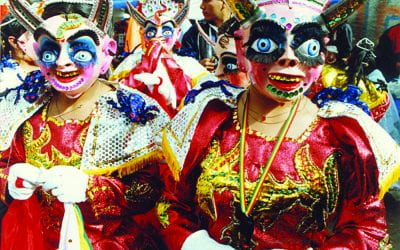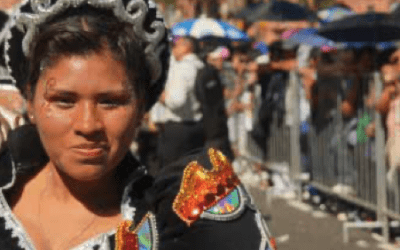Fiesta Politics
A Rehearsal—and an Act—of Governance
Zaída García sat at a table in the middle of a small storefront facing the plaza of Ocumare de la Costa in Venezuela. She was busy working late at night, drawing a map for the nearby community of Cumboto. “It takes many hands,” she said, looking up from the page neatly penciled with roads and walking paths, houses and their family names, signs and landmarks. Leaning against the wall of the small space were several instruments: a cuatro, congas and a long three-person mina drum. Just above, a poster of the patron saint San Juan Bautista added a splash of red color from his finely adorned robes, matching García’s red pro-Chávez shirt with a small handprint on the pocket. In 2010, García’s job as an organizer was to work with thousands of people staging music events, classes on culture and the arts, dances and popular fiesta. The following year, García was elected mayor.
García’s election to this official rank of political power in Ocumare, as an organizer in the cultural arts and as a woman of African descent, says something in itself about the changing politics in Venezuela as it generates socialism of the 21st century. Yet, what Zaída García said that night revealed an often dismissed aspect of politics: the power of cultural performance, fiestas and the popular arts in the practice—both in the sense of rehearsal and also the act—of governance. Especially when witnessing the production of Ocumare’s fiestas and religious manifestations that involve hundreds of people in this small town (pop. 9,000), cleaning streets, arranging flowers, cooking food, conducting traffic and helping to facilitate and regulate different aspects of these sometimes multiple day events, I find that I continuously turn back to the idea of “many hands” or what I call “multiple arms of production” in thinking about how fiesta and other forms of cultural performance intersect with the political acts of governance.
Popular fiesta is a participatory act. Hands create; they make; they express. Arms connect and lift, they are limbs of body that provide the vital conduit to the whole for the work of many. The idea that “it takes many hands” is one of the key tenets of popular fiesta and also of participatory politics, where “Participation,” as Olga Pizano Mallarino, Luis Alberto Zuleta and Lino Jaramillo write in their book La fiesta, la otra cara del patrimonio, “is fundamental to the production of popular fiestas in bringing together neighborhoods, authorities, means of communication and economies” (Convenio Andrés Bello, 2004: 113). When dozens make masks, and dozens more sew costumes, build altars, cook food and convene rehearsals, popular fiesta and other large-scale popular performances are participatory acts. Furthermore, when thousands of people sing together and move along a processional path, boundaries—both physical and otherwise—are renewed and forged in what Charles Tilly calls the reproduction of political boundaries that are continually set and negotiated in law, language, social rules, and kinship systems— where fiesta includes all of these.
Popular fiesta is a political act. Where “many hands” in fiestas lift up, carry, push inward, and through what may be soulful, devotional, or secular, or utopian sensibility—there is another dimension, which is the multiple points of agency and production that lift up and carry what is also a political body. In other words, fiesta and carnival may indeed involve the spectacular, the playful, the comunitas, and what Milla Riggio describes as a release from the “workaday” world (Carnival in Action, 2004). Yet, large-scale, popular performances also significantly involve material production and order, the rules and the organizational means to achieve collective action with far-reaching and substantial implications in the governance of everyday life. In other words, fiesta is not necessarily in opposition to the laws of production and productive labor, rather it makes its own.
By political, however, I’m not referring necessarily to campaigns or partisan politics. In Ocumare, partisan politics happens outside of fiestas and popular religious manifestations with most organizers making clear distinctions between what they do in their work as activists or in affiliations with a particular policy, party or candidate and their involvement in these events. While the PSUV (Chávez-Maduro) party has taken a stronger role in the region and many fiesta organizers support it, others do not, and all generally agree that fiestas and religious manifestations are officially unaligned and open to everyone.
Popular fiestas activate networks. Where García’s work may seem exceptional, the idea that “it takes many hands” in relation to governance is connected to long-held networks of people who work at the seams of both social services and fiesta. These public events involving music, dance and devotional ritual are inseparable from the multiple nodes of production including massive food preparation, tending to streets and houses, recording of information, material exchange and labor, and taking care of the elderly and infirm. Religious manifestations, carnivals and fiestas are performances in which multiple arms of production generate and also manage some of the basic functions of civic life and administration.
Fiesta is about governance: governance of land, people and place. Further west from Venezuela, in the Sierra Madre mountain town of Atanquez, Colombia, a small group of women and men sit in fold-up chairs by the side of the road. The day is Corpus Christi Thursday 2011. As a car pulls up, two men and a woman draw a rope tight across the road with a handwritten sign for the “fiestas of the patron saints.” The rope would be released upon receipt of a road tax for the Pro-Fiesta Committee. This fiesta toll or retén, not uncommon in other towns throughout Latin America, exercises both the fiesta’s right to establish a public funding system and its organizers’ control over the entrance to the town. While the act may be temporary and is not enforced by the army or police, the fact that these organizers establish the retén—as they have done for decades—presents an important degree of agency and power for fiesta rules.
This basic and yet significant act of the local committee to both symbolically and materially control the road leading to the fiesta is, recalls what Ngugi wa Thiong’o describes in Penpoints, Gunpoints, and Dreams, a performance of state where, “The nation-state performs its own being relentlessly, through its daily exercise of power over the exits and entrances” (21). This road stop is, of course, a very different act of governance than that of the state. The fiesta retén did not prevent the Colombian national guard from setting up a checkpoint further up the road. Furthermore, the road leading in to Atanquez, known as the “road of death,” where dozens of Kankuamo people since the 1990s have been murdered and left by the roadside mostly by paramilitary alliances, raises serious questions about the role of the state in both the ongoing violence, and in “official” government claims of reconciliation. Especially in a region where fiesta leaders have been targeted in those crimes, it’s important to further recognize that the Organización Indígena Kankuamo and the three other native peoples in the Sierra Nevada Mountains—identified together as a fogón, or a four-legged basin—demand to fully govern their own territories—and that fiesta is one of the means to do so. Fiesta organizers, too, exercise their power over the entrance of their town with the toll rope, where they and the community that authorizes them act as their own governing body. While these are ongoing negotiations, fiesta in this case operates “as if” it were the state to rehearse an alternative system of rules and conduct.
Renowned Brazilian theater practitioner Augusto Boal brings this idea of participatory performance of fiestas and governance into even closer view. In Aristotelian theater, Boal argues, the doings of the world on stage pacify its audience, resulting in a purge of the very impetus for the action needed to change society. “Dramatic action,” Boal writes, “substitutes for real action,” where the divide between actors and spectators, the installment of the protagonist hero, catharsis, and other devices of the ancient (and modern) stage essentially disengage people from their right to govern. Conversely, in a theater practice of liberation, Boal writes, “The spectator no longer delegates power to the characters either to think or to act in her/his place. The spectator frees her/himself; s/he thinks and acts for her/himself!” Thus, Boal famously concludes, “Perhaps the theater is not revolution in itself, but have no doubts, it is a rehearsal of revolution!”
As “masses” detached from the means to produce our own collective action, we are usually stripped of the ability to practice or rehearse governance. Fiesta as participatory practice provides a means of purposeful engagement with cultural and regional affiliations so often co-opted by the state—where we are coerced into relinquishing our own controls, rules, language and authority.
While Boal’s view of early forms of performance of “free people singing” (of any number of performance practices in the Americas: mitotes, areitos, kutsu, candomblé, or European-influenced carnivals of the Middle Ages, to name a few) may idealize them, countless studies have also shown the ways fiestas appropriate, co-opt or silence histories. In some cases, they are hijacked; in other cases, they were created to propagate violence, increase inequality, or exist to produce as much exclusion as inclusion. While they have a liberating potential, there are also dangers, and fiestas should not be mistakenly assumed to be equivalent to liberating alternatives.
Nevertheless, there is an important potential in fiestas as rehearsals or acts of governance. Rather than a release valve for lawless confusion or chaos, or events that are suggestive of merely moral or cultural realms, fiestas can tell us a great deal about what a participatory governance might look like, and how governance can function differently. Whatever we ultimately choose to carry on for future generations must be deliberated. However, in the act of governing those choices, the many hands of fiesta can help carry it to fruition. As open-air, networked, and multitudinous acts of singing, poetry reciting, procession, and dance, fiestas offer ways to move further towards how to govern ourselves.
Spring 2014, Volume XIII, Number 3
Angela Marino, Ph.D., is an Assistant Professor at the University of California, Berkeley. She is co-editor of Festive Devils of the Americas (Seagull Press/University of Chicago), and is currently writing a book on performance and populism in Venezuela.
Related Articles
Colombian Devils
The devils from Europe and Africa arrived in Colombia and as soon as they encountered the indigenous devils, they happily got together to amuse themselves. They take advantage of any…
Whose Skin Is This, Anyway?
An African-American dresses as a Plains Indian, as if seen through the lens of Fellini, while Andean natives wear white masks and carry whips, pretending to be colonial overseers. Whites…
Making a Difference: A Tale of Two Centuries
Harvard’s ties to Latin America go much farther back in time than 1994, the year that Neil Rudenstine and David Rockefeller launched the David Rockefeller…





